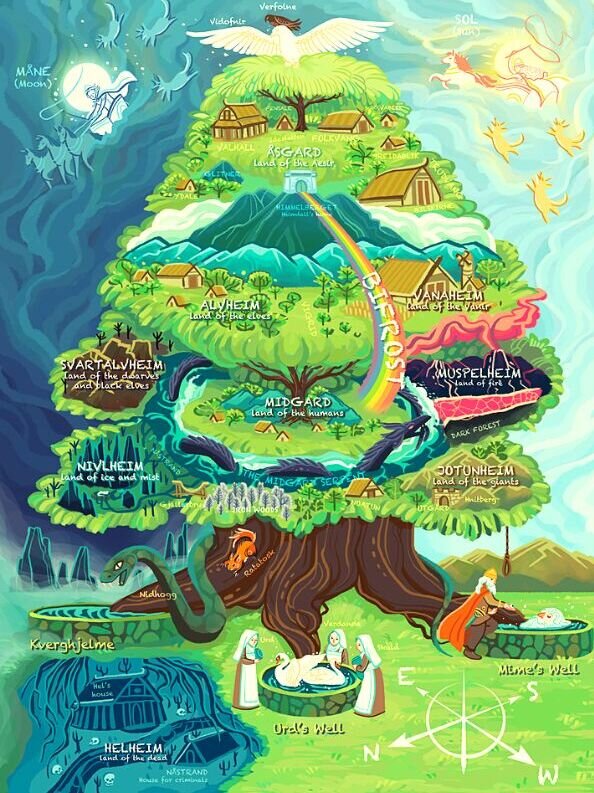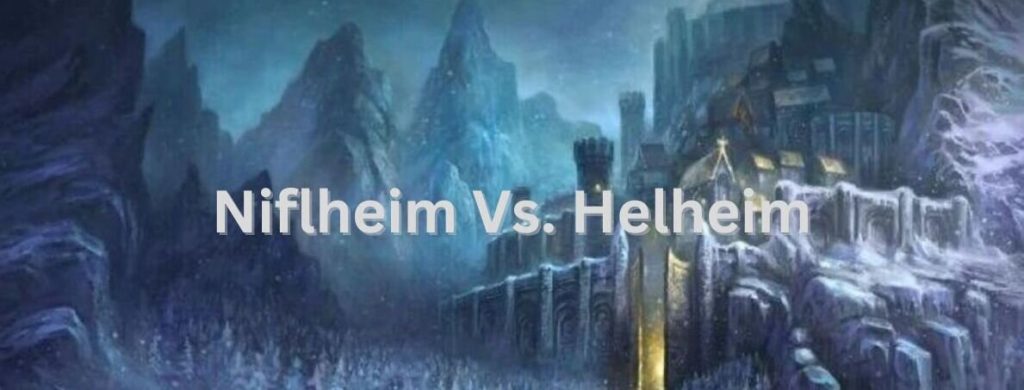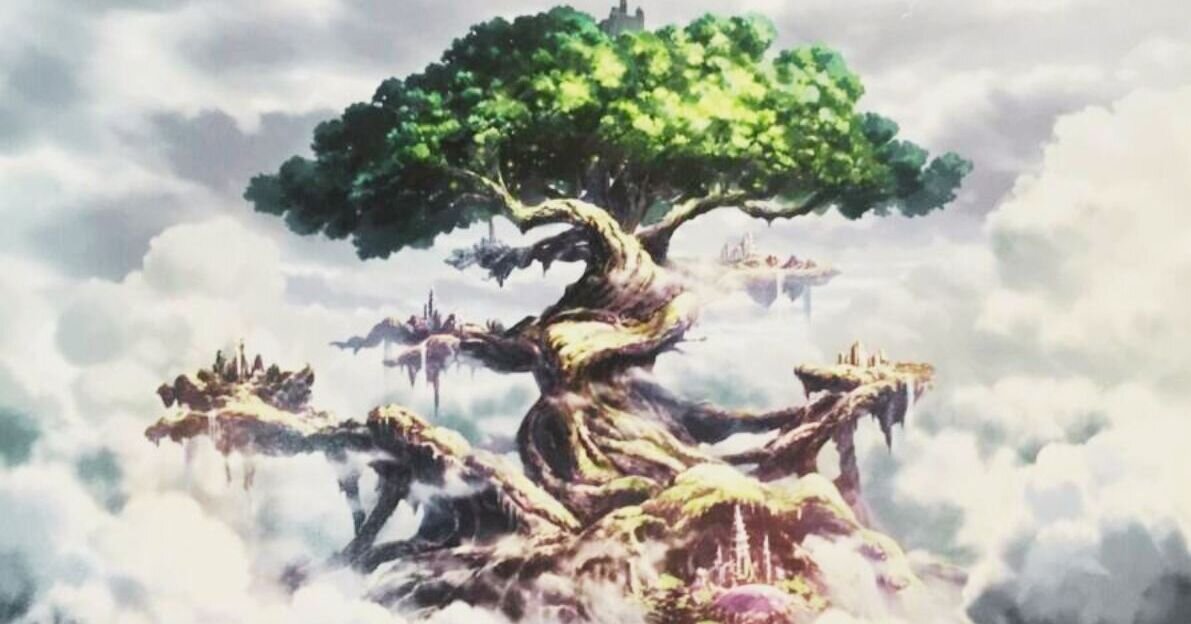In Norse Mythology, there is a primordial void referred to as Ginnungagap. From that primordial void, the tree Yggdrasil (or the world tree) and the two realms known as Niflheim and Muspelheim were born. The remaining realms were created by Odin using the body of Ymir to make the world. These are Alfheim, Asgard, Hel, Jotunheim, Midgard, Svartalheim and Vanaheim.
These nine realms are connected by the roots of Yggdrasil and are home to various beings from Frost Giants, Æsir gods, and men. Let’s take a quick look at the nine different realms and how they came to be.
The Nine Worlds
It all starts with the World Tree (Yggdrasil). The large branches of Ygdrassil reach far into the sky and deep into the earth. From those branches, the nine different worlds of Norse mythology are connected.
Let’s dive into the nine realms and their significance in old Norse sagas.

1. Alfheim
Ruler: Freyr
Alfheim (Álfheimr) is the realm of divine beings known as the light elves. These beings help the Midgardians in fertility and are divine beings of nature.
Sometimes the light elves of Álfheimr are also referred to as guardian angels and are regarded as a type of muse that inspires human art and music.
2. Asgard
Ruler: Odin
Asgard is located in the center of the world and is the home of the Æsir gods, such as Thor, Loki, Frigg, Freyja, and other powerful old Norse gods. The only access to Asgard from Midgard is via the rainbow bridge known as the Bifrost.
Fallen Nordic Viking warriors that died in battle are escorted to the halls of Valhalla (a palace of fallen warriors within Asgard) to train and prepare for the end of the world, also known as Ragnarök.
3. Helheim
Ruler: Hel, the daughter of Loki
When you die, you are either escorted to Valhalla or Fólkvangr. However, if you didn’t die heroically in battle or died of old age, you went to Helheim.
Helheim is very similar to modern interpretations of Hell. It’s dark and cold, and residents of Helheim live out the rest of their days suffering.
In the final days, the residents of Hel return to fight against the Æsir gods at Ragnarök.
4. Jotunheim
Ruler: Þrymr
Jotunheim, aka Jötunheimr, is the home of the Frost Giants or the jötnar. It’s a wintry landscape with infertile soil, heavy snow, and extensive forests.
The Frost Giants, or jötunn, are constantly at odds with the Æsir gods, as told in many poems in the Prose Edda and Poetic Edda.
5. Midgard (Earth)
Midgard in Norse mythology is the home of humans and Vikings and was made from the flesh of Ymir. It is positioned between Niflheim and Muspelheim.
Midgard is surrounded by a giant ocean guarded by the Midgard Serpent that circles the entire world. The only way to access Asgard from Midgard is via the Rainbow Bridge, also known as the Bifrost.
6. Muspelheim
Ruler: Surtr, or Surt
Muspelheim is the realm of fire, not to be confused with the modern interpretation of Hell. It’s the home of the fire giants that live in a world filled with fire, ash, lava, and soot.
It’s a smoldering inferno, and the fire giants that live here are sworn enemies of the Æsir gods, much like the Frost Giants. During Ragnarök, Surtr descends upon Asgard and transforms it into a firey nightmare landscape.
7. Niflheim
Ruler: Hel
Niflheim was one of the first two realms in existence that came from the Ginnungagap. It’s a cold and lonely landscape that is also referred to as the World of Mist. It’s very similar to the Hel (and some think that Hel and Niflheim are the same place).
The gods and goddesses that deem humans unworthy of Valhalla go to Niflheim when they die. In Ragnarök, the residents of Niflheim battle the residents of Valhalla.
8. Svartalfheim
Ruler: Hreidmar
Svartalfheim, sometimes referred to as Niðavellir, is a deep underground world consisting of cave structures. It translates to ‘dark fields,’ and it’s the home to the dwarves.
The dwarves were skilled craftsmen and even constructed weapons for the Æsir gods, such as Odin’s Spear, Gungnir and Thor’s hammer Mjölnir.
9. Vanaheim
Ruler: Freyja
Vanaheim is the home of the Vanir gods. While the Vanir gods were once at war with the Æsir gods, they eventually called a truce, and the two old gods continued to live in harmony.
Vanir gods are skilled sorcerers, including gods such as Njord, Freyr, Freyja, and Nerthus.
The Issue With Helheim/Niflheim

Did you notice a bit of an overlap between Helheim (or Hel) and Niflheim? Both realms are ruled by Hel, Loki’s daughter. So, what’s the difference between Helheim and Niflheim, you ask? The answer isn’t entirely clear because many passages in the Prose Edda contradict themselves.
Niflheim only appears in Snorri Sturluson’s Prose Edda (a more modern and Christianized version of the words in the Poetic Edda) in the Gylfaginning and doesn’t appear in the Poetic Edda at all. To make matters even more confusing, a place called Nifhel is described in the Prose Edda as where people in Helheim go when they die.
One could surmise that there’s Hel and an even darker place (Niflheim) where those who die in Hel travel. Or, some scholars believe that Hel, depicted by Snorri Sturluson in the Prose Edda, was just a realm shaped by his Christian beliefs.
Snorri Sturluson’s Role In Defining The Nine Worlds
Snorri Sturluson was the author of the Prose Edda, which compiles 31 poems of the Poetic Edda and provides detailed explanations and descriptions of the meaning found within. In the early days of Norse cosmology, the sagas didn’t offer much insight into the foundations of the nine realms.
It wasn’t until Snorri Sturluson penned the Prose Edda that we gained a clearer understanding of the nine worlds and their meaning without the sagas of Norse mythology.
While Snorri offered great insight into the nine realms, his account may not be accurate. Snorri wrote the Prose Edda through a Christan lens (because he was a Christan, not a Pagan).
*Make sure to check out my article on Norse Paganism Vs. Christianity.
For instance, the descriptions of some of the worlds, like Hel, were painted in a way that mirrored the Christan idea of Hell, or eternal punishment. It’s entirely possible that the realm of Hel did not exist in old Nordic texts.
Despite clear Christian-leaning intentions, Snorri significantly shaped and understood the nine realms of Norse mythology and helped better understand the origins of the Germanic Norse gods.

